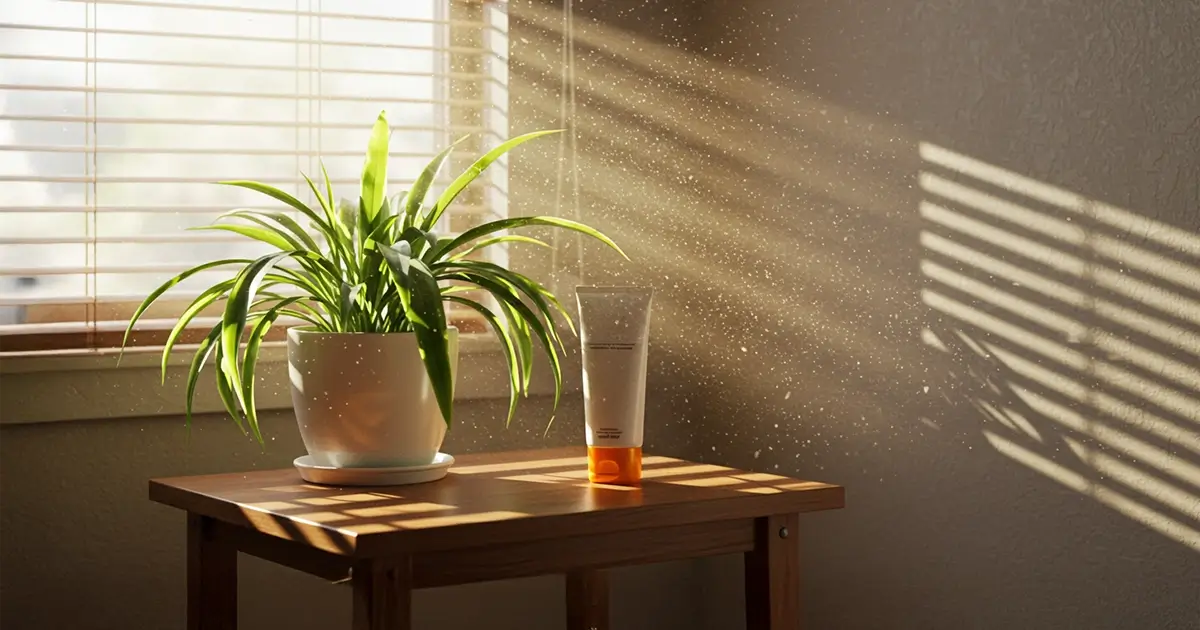Staying inside feels protective, yet light sneaks through windows and screens more than most people realise. Today I unpack what slips past glass, why some rays still age skin, and how to build a realistic indoor sun-care routine - all in a swift seven-minute read.
Why Indoor Light Deserves Respect
I used to think my living-room walls formed an invisible force field, then I read a research poster showing office workers collect up to sixty per cent of their daily UVA dose without ever stepping outside. That number shocked me, but it made perfect sense once I remembered the tell-tale one-sided freckles drivers often get.
Ultraviolet A wavelengths travel deeper into skin than UVB, triggering collagen breakdown and pigment changes. Even ordinary window glass only filters some of that longer energy, so cumulative exposure adds up quietly, rather like the "just one episode" button when I binge a new series.
Visible blue-violet light, especially between 400 and 500 nm, plays a different game. It can worsen hyperpigmentation in darker tones and may set off oxidative stress pathways. While intensity indoors is lower than on a beach, daily proximity to laptops and LED bulbs keeps the tally ticking.
UVA's Journey Through Glass
A January 2025 study in the Archives of Dermatological Research measured car, office and home panes. Results showed tempered side windows let through roughly 70 per cent of UVA, while laminated windscreens blocked almost all UVB yet allowed about 10 per cent of UVA. Standard household windows sat somewhere between those two figures.
Although ten per cent sounds tiny, multiply that by eight working hours and three hundred office days: the annual dose rivals several long summer walks. Pigment cells do not record intent, only photons received.
Manufacturers now sell low-e or UV-absorbing films, but adoption remains patchy. Until every landlord refits glazing, personal protection fills the gap.
Blue Light From Screens and LEDs
Unlike UVA, blue light reaching your face at home comes from both the sun and gadgets. A 2023 review in the Journal of Cosmetic Dermatology linked high-energy visible light to oxidative markers and persistent dark patches, particularly in Fitzpatrick types IV to VI.
Blue photons carry less energy than UVA, yet they scatter widely within the dermis. That scattering generates reactive oxygen species, which then nibble at lipids and DNA. Hyperpigmentation, dull tone and uneven texture are the unwelcome souvenirs.
Before you boycott all electronics, remember dose matters. Night-owl coding sprints under a bright desk lamp still deliver less blue light than midday sun, but protective habits help tilt the balance in your favour.
Evidence That Indoor Rays Cause Real Skin Change
Dermatologists first suspected indoor photoageing when they noticed asymmetrical wrinkles on drivers' faces. Subsequent imaging confirmed higher elastosis on the window-side cheek. Science eventually followed those clinical breadcrumbs.
In vitro fibroblast cultures exposed to low-dose UVA showed reduced type I collagen after only two hours. The exposure matched light levels measured beside an office window on a hazy spring day, so laboratory relevance checks out.
Melasma specialists later observed that blue light combined with UVA provokes longer-lasting pigment than UVA alone, hinting at a synergistic punch. That explains why some patients struggle despite daily SPF, if their product stops at UV filters.
Car Window Data Translating to Homes
The 2025 vehicle-glass paper calculated that side-window UVA transmission could deliver up to forty joules per square centimetre on a two-hour commute. Living-room panes share similar composition, meaning the dose for a couch potato marathoning a drama series can quietly equal or surpass that commute.
Researchers also noted mileage increased UVA blockage in older cars because minute scratches scatter light. Ironically, new spotless windows can be more transparent than your beloved fifteen-year-old hatchback.
Takeaway: pristine picture windows look gorgeous but offer less passive protection than you hope.
Blue Light Hyperpigmentation Trials
A split-face study on thirty volunteers with darker skin types compared half faces under blue light plus UVA to the other halves under UVA alone. After one month, investigators measured a forty-three per cent uptick in melanin index on the blue-light half. Pigment also lingered longer.
Topical antioxidants suppressed part of that melanin spike, hinting that oxidative stress sits upstream. Still, antioxidants did not fully erase the disparity, so a physical barrier remains crucial.
If you ever asked, "Why do my post-acne marks fade slower on the side facing the window?" now you know.
When and How to Use Sunscreen at Home
No one expects you to slather SPF for a midnight fridge raid, yet strategic application pays dividends during daylight hours. Assess three factors: proximity to windows, length of exposure, and underlying pigment concerns.
If you work within two metres of glass, apply broad-spectrum SPF 30 or higher at least once, even on cloudy days. Cloud cover hardly dents UVA levels, and scattered rays still reach indoor corners.
People with melasma, recent chemical peels, or ambitious anti-aging goals benefit from tinted formulas that block visible light. The American Academy of Dermatology notes tinted sunscreens containing iron oxide extend protection beyond UVA and UVB into blue-violet wavelengths - handy for stubborn dark spots (AAD Sunscreen FAQs).
- Pick broad-spectrum SPF 30 as a minimum, SPF 50 if you sit beside a panoramic window.
- Choose water-based or gel textures for oily skin to avoid midday shine.
- Tinted mineral sunscreens offer a visible shield without the ghostly cast.
- Set a calendar ping to re-apply every four hours of indirect sun exposure.
- Combine with sheer curtains or UV films for belt-and-braces defence.
- Remember ears and the back of your hands, they face screens, too.
- Wash off gently before bed, your pillowcase prefers a clean canvas.
I once skipped the re-application reminder and discovered, after a seven-hour strategy call, that my left cheek had tanned just enough to match my bronzer, proving that light adds colour even while you chase deadlines.
Choosing Products and Other Indoor Shields
Modern sunscreens fall into three broad camps: purely chemical, mineral, and hybrid. Indoors, where sweat is minimal, the decision leans more on personal comfort and visible-light coverage than on heavy water resistance.
Mineral filters such as zinc oxide reflect UVA efficiently but leave sheen. Pigment-grade iron oxide bridges the gap by absorbing blue light. Many hybrid formulas now blend all three for full-spectrum coverage without pasty residue.
Packaging claims often shout numbers, yet finish matters. A formula you enjoy is the one you will actually use, so sample textures until you find a match.
Tinted Sunscreens: Not Just Cosmetic
Tint sounds purely aesthetic, but iron-oxide pigments in those shades attenuate wavelengths beyond 400 nm. Clinical trials showed participants using tinted mineral SPF 50 experienced thirty-per-cent less relapse of melasma over twelve weeks compared with un-tinted controls.
If the word tint scares you, many modern shades sheer out, leaving no obvious makeup look. I promise your houseplants will not tease you for wearing a whisper of colour.
For a deeper dive on device-emitted light, see my earlier post about blue light myths here, then decide if you need an extra layer of pigment.
Physical Barriers and Smart Layout Tweaks
Curtains with tight weave fabrics cut UVA by up to ninety per cent, though texture choice affects room ambience. Sheer polyester may halve light yet keep workspaces bright.
UV-blocking films cost less than new windows. These thin laminates filter 99 per cent of UVA, reduce glare, and conserve energy. Installation takes one afternoon, making them a quick win for rented flats.
Finally, pick workstations wisely. A desk placed perpendicular to windows lets you enjoy daylight while minimising direct beam exposure. Plants on the sill act as charming scatter filters, plus they remind you to water something beyond your own epidermis.
FAQ
Do LED screens emit enough blue light to harm skin?
Monitors emit far less blue light energy than midday sun, but long, close-range sessions still contribute to oxidative stress. A lightweight antioxidant serum under SPF gives extra insurance.
Is SPF 15 in my moisturiser enough indoors?
SPF 15 blocks about 93 per cent of UVB, yet only if applied in sunscreen-level amounts. Indoors you meet UVA and visible light too, so a separate broad-spectrum SPF 30 or higher is safer.
Can I skip sunscreen if my windows have UV film?
Films remove most UVA, but they do not tackle visible blue light completely. If you have pigment issues or sit with screens, keep sunscreen in the routine.
Do darker skin tones need indoor sun protection?
Yes. Visible light stimulates melanocytes in deeper tones, making dark spots linger. Tinted mineral sunscreens or iron-oxide powders help control that trigger.
How often should I re-apply sunscreen at home?
Every four hours of daylight exposure, sooner if you sweat while doing home workouts or cooking steamy meals.
Will ordinary curtains protect as well as special films?
Heavy fabrics block most UVA, but they also darken the room. Layer light-filtering sheers with strategic blinds to balance brightness and protection.
Conclusion
Indoor life is not a free pass from photodamage. UVA slides through clear panes, and visible blue light tags along with every spreadsheet you open. Tinted, broad-spectrum sunscreen plus smart room design keeps those stealth rays in check.
Got questions or a favourite indoor SPF? Share below. See you in the next post - until then, take good care of your skin!


Comments (0)
No comments yet - be the first to share your thoughts!
Leave a Reply
Your email address will not be published. Required fields are marked *